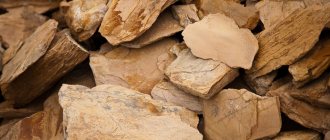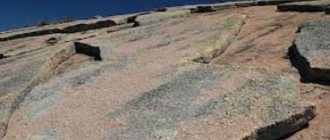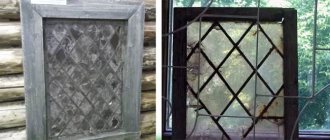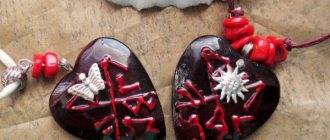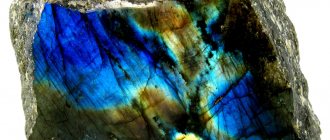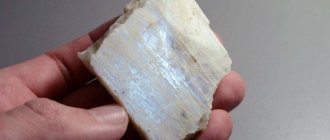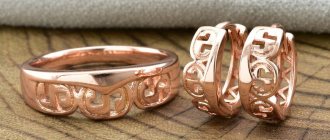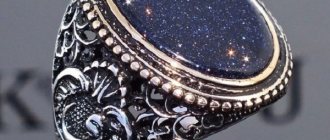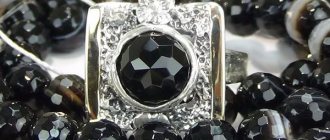Talc
- mineral with the formula Mg3Si4O10(OH)2. Synonyms: agalite (fine-fiber), steatite, wen (dense, massive). It is a greasy, crumbly powder of white (occasionally green) color. The quality of talc is determined by its whiteness. For industrial purposes, ground talc, microtalc, etc. are used. It is worth noting that talc is a mineral that is almost insoluble in water and acids. The necessary conditions for the formation of talc are a temperature of about 400 ° C, a sufficient amount of water (after the transformation of minerals from rocks rich in iron and magnesium).
- Structure
- Properties
- Morphology
- Origin
- Application
- Classification
- Physical properties
- Optical properties
- Crystallographic properties
See also:
Agate
- price and medicinal, magical properties
Physical properties and structure of diamond
STRUCTURE
The mineral talc has a crystalline (usually rhombic) structure. In nature it occurs in the form of leafy granular layers. It is a secondary mineral that is formed when magnesium silicates, which do not contain aluminum (Al), change their chemical composition.
The crystal lattice of talc is formed by a layer of magnesium oxide, framed by two layers of non-polar tetraers of quartz and oxygen. The outer surface of the flakes contains neither hydroxyl groups nor active ions, which determines the high chemical resistance and hydrophobicity of talc. Three-layer talc crystals, having a very strong internal bond, are very weakly connected to each other.
Talc in cosmetics
Cosmetology is one of the industries in which this mineral is widely used. It has antibacterial and absorbent qualities. The absence of crystalline quartz and amphibole in it allows the production of environmentally friendly and healthy products. Powders, powders and dry antiperspirants are made from it. The powder is also widely used in decorative cosmetics. For example, 80% of eye shadow is talc. The price for 200 g of powder is about 50 rubles. Before being added to cosmetic products, talc undergoes thorough processing and is cleaned of microbiological elements. When working with it, it is important to know what talc is and what dangers it poses. After all, this substance is toxic - inhaling it causes serious lung diseases.
PROPERTIES
Talc is a recognized standard of softness of natural materials. Color ranges from light apple green to white and silvery white, sometimes yellowish. The luster is greasy, pearlescent on the cleavage planes. The cleavage is very perfect. Translucent at the edges, transparent in thin leaves. The cleavage is very perfect according to (001). Hardness 1 (minimum) on the Mohs scale. Oily to the touch. Under the blowpipe it turns white and breaks up into small sheets; melts with difficulty, forming white enamel on the edges.
Description of the mineral and its properties
Talc is a translucent mineral that is green, white, gray, brown or colorless. Sometimes other shades of stone are found, such as red or burgundy. It has a sheet structure, like mica. The sheets are held together only by van der Wals bonds and easily slide relative to each other. Thanks to this, talc is the softest mineral. It has a greasy and soapy feel to the touch , which allows it to be used as a high-temperature lubricant (melting point is about 160ºC). When heated, it becomes harder and has weak electrical conductivity.
The quality of the mineral depends on the degree of whiteness of the crystals
We also recommend reading:
The history and curse of the Kohinoor stone The marvelous ametrine stone Characteristics of larimar and its main properties Selection of stones by date of birth
Most talc is produced in China, the USA and Japan. In Russia, deposits are located in the Urals and Siberia. The quality of the mineral depends on the degree of whiteness of the crystals. During the extraction process, efforts are made to avoid contamination with other rocks that could have a negative impact on the color of the product. Impurities are removed using froth flotation or mechanical treatment. Mills produce crushing to the sizes required by customers.
MORPHOLOGY
Depending on the structure and mineral additives, some types of talc have their own names. Thus, minnesoaite is a talc in which magnesium is isomorphically replaced by iron. It has a brownish color. Willemseite - magnesium in the mineral formula is isomorphically replaced by nickel (stone color - green, blue).
Very dense, massive talc is called steatite or wen. Not so common is talc, which consists of long, tangled, parallel-fibrous, asbestos-like crystals. It is called agalite.
There are also very beautiful varieties of talc aggregate - dense, white and translucent, which tolerate stone cutting and polishing well. They are called noble talc.
In deposits, talc is found together with chlorite, clinochlore, serpentinite, tremolite, and other minerals of the pyroxene and amphibole groups. can form aggregates when mixed with chlorite (talc chlorite).
Minerals, mining
The origin of talc is dolomite - the impact of hydrothermal waters transforms dolomites into talc-containing rocks.
Types of minerals:
- willemseite;
- agalite;
- steatite (soapstone, soapstone);
- Minnesotait;
- noble talc; white, translucent, dense mineral, tolerates polishing and cutting well.
Talc minerals are mined all over the world.
For those who like to drink whiskey cold, but not diluted with ice: good bartenders have soapstone cubes in their freezer for this purpose. They are placed in a glass with a drink. We recommend: Many faces of QUARTZITE STONE
ORIGIN
Talc is formed as a result of the interaction of dolomites and water from hot springs. Soapstones of various impurity composition are a consequence of the reactions of silicic acid decomposition of magnesian rocks.
Talc deposits are ubiquitous. However, only in Brazil are large (up to 5 cm) crystals of talc covered with a quartz crust found. The United States has remained the champion in industrial talc production for many years. Canada, France, Russia, and the countries of the Far East are famous for the development of high-quality talc.
In Russia, the Shabrovo talc-magnesite and Miass talcite deposits are being developed in the Middle Urals, the Onotskoye deposit of steatite (solid) talc (Eastern Sayan); The Western Baikal talconiferous province has been identified. Abroad, large deposits are known in Canada (Maidoc), USA (Gavernur), France (Luzenac), etc.
History and deposits of stone
Talc is called by the Persian word talc or Arabic talq. In translation, both mean “pure”, “white”.
The stone has been used for a long time. 7,000-year-old Egyptian talc jewelry, Sumerian seals, and Greek and Roman cameos have been found. A Russian master carved an icon of Dmitry of Thessaloniki from mineral.
Talc is found in many countries in Eurasia, Australia, Africa, North and South America. There are deposits even in Antarctica.
Main deposits:
- Luzenac (France);
- Baikal region, Ural (Russia);
- Governor (USA);
- Onotskoe (Eastern Sayan);
- Maydoc (Canada).
Talc is mined by open-pit mining. They are developed only with technology (without explosions). On site, the monolith is sawed into rectangles, and the waste is crushed into powder.
We bring to your attention a video of the Baikal landscapes from the site of mineral extraction:
See what an abandoned stone quarry in the Urals looks like:
APPLICATION
This mineral has long been firmly established in various areas of human activity and life. Since the end of the nineteenth century, it has been used as a powder that is used to coat rubber, caoutchouc, and plastic technical products so that they do not stick together upon contact. In the sex industry, it is used for storing all kinds of toys by treating surfaces with talc-based powders. In the notorious "magical practice" talc was used to prepare potions, with the help of which, as some believed, youth and beauty could be restored; these were various creams and ointments that acted on the skin as cosmetics, but nothing more.
Since about the same time, finely ground talc has been used as baby powder. This mineral can decompose in the human stomach and be a source of magnesium and calcium (used in calcium gluconate preparations, dietary supplements).
Talc is used as an additive and filler in foods. The European Food Standardization Organization calls it food additive E553b.
Talc is a filler for tablets, paper pulp, varnishes and paints, ceramics, cosmetic products, and insulators. This mineral is even added to motor oils as an additive, which increases the life of engines.
An important area of application is ceramics (especially radio-insulating).
Talc - Mg3Si4O10(OH)2
| Molecular weight | 379.27 g/mol |
| origin of name | from Persian "talc" to Arabic "talq", - pure |
| IMA status | valid, first described before 1959 (before IMA) |
What are the health risks of talc?
For many years, talc for external use was considered a completely safe product. But recent studies claim that in some cases the powder can cause damage to the body.
Harm of talc in tablets
Additive E553, made on the basis of talc, is recognized as a substance with moderate harmfulness. In Russia and the CIS countries it is used without restrictions, but in Japan it is prohibited for use because it is considered carcinogenic.
Talc is present in medications in minimal quantities. With dosed use of pharmacological agents, the substance does not cause harm. But if the instructions are not followed and if it enters the body in excess amounts, talc can cause:
- nausea;
- dry cough and bronchitis;
- shortness of breath;
- vomiting;
- insomnia.
We recommend reading: Food additive E501i: dangerous or not, effects on the body
An overdose of the substance can lead to a decrease in blood pressure and weakness.
The effect of talc on the body of children, pregnant women and nursing mothers has not been fully studied
Harm of talc in cosmetics, eye shadows
The potential harm of talc to the skin is that in excess quantities the powder can clog the pores of the epidermis. At the same time, the product's comedogenicity index is very low - only 1 on a scale from 0 to 5. If you apply the powder to thoroughly cleansed skin in small quantities, the product will remain on the surface of the epidermis and will not cause any harm. But with poor personal hygiene, the powder will interfere with the processes of cellular respiration and will only worsen the condition of the face and body.
The benefits and harms of talc powder are determined by the careful use of the product. Any decorative cosmetics, including those containing adsorbent powder, must be thoroughly washed off the face every evening. Otherwise, powder residues will accumulate on the skin, clog the sebaceous ducts and contribute to the occurrence of acne and comedones.
Talc in medicines and cosmetics can cause harm to the body if the powder itself is of poor quality. In particular, in some cases the powder contains admixtures of carcinogenic asbestos. But certified medicines and products for external use contain only purified talc, which does not provoke the development of malignant processes.
The dangers of talc in toothpaste
Talc is used as a thickener in toothpastes. When used correctly, the hygiene product does not cause any harm to the oral cavity or the body as a whole.
Side effects from talc can only develop if you frequently swallow large quantities of toothpaste. If used incorrectly, the hygiene product can cause nausea, vomiting and stomach discomfort.
Contraindications to the use of talc
High-quality pure talc, when used carefully, rarely has a negative effect on the body. When using cosmetics containing minerals and baby powder, it is recommended to avoid inhaling the powder. Exposure to the respiratory tract may result in:
- to talcosis - the occurrence of a dry cough and shortness of breath;
- to chronic bronchitis;
- to tuberculosis.
Although the carcinogenicity of talc has not yet been proven, powders based on it are not recommended to be applied directly to the skin of the external genitalia in case of irritation and inflammation. Some researchers claim that frequent use of the powder significantly increases the risk of developing ovarian and endometrial cancer.
The only strict contraindication to the use of talc is individual hypersensitivity
PHYSICAL PROPERTIES
| Mineral color | colorless, white, greenish-white, pale green |
| Stroke color | white |
| Transparency | translucent, opaque |
| Shine | greasy, pearly, dull |
| Cleavage | very perfect in {001} |
| Hardness (Mohs scale) | 1 |
| Kink | not uniform |
| Strength | cut and easily wrinkled |
| Density (measured) | 2.58 - 2.83 g/cm3 |
| Radioactivity (GRapi) | 0 |
Talc: what is this mineral?
It is often said that talc is the most common material. This happens because it is used in many areas of human activity.
The range is actually wide: from industry to medicine. Sometimes when mining you come across stone talc, that is, coarse-grained, it is often called steatite. For reference, see photo.
This name came to us from Arabic. It is a friable substance, essentially a powder. Sometimes they say that it feels greasy (otherwise oily) and very soft.
Most often white, but sometimes greenish, this is the norm. It is believed that the higher the quality of the talc, the whiter it is.
Of course, talc used for industrial purposes is of rather low quality, often gray or gray-green, dirty in color. The shine of talc is called pearly.
OPTICAL PROPERTIES
| Type | biaxial (-) |
| Refractive indices | nα = 1.538 – 1.550 nβ = 1.589 – 1.594 nγ = 1.589 – 1.600 |
| Maximum birefringence | δ = 0.051 |
| Optical relief | moderate |
| Pleochroism | weak colorless, pale green |
| Dispersion | r > v tangible |
| Luminescence in ultraviolet radiation | fluorescent, with short-wave UV - orange-yellow, with long-wave UV - yellow |
How to use talc?
In hot weather we sweat, it's unpleasant, but true. Antiperspirants only partially help, and clothes tend to stick to damp skin and become wet spots. If we are on the beach or have the opportunity to shower whenever we want, this is not such a problem. What if this is not possible? It is at such moments that powder can come to the rescue. It is applied like a powder to the desired areas of the skin. This could be the décolleté, chest, stomach and back or lower back, that is, those areas that are most susceptible to sweating.
If you have problems such as rubbing of the inner thighs, you can protect yourself in the heat with clothes like trousers or nylon tights, or you can use powder instead of these barbaric methods. Simply apply it to problem areas of the skin with a makeup sponge or rub in with your hand.
But you should apply this miracle powder to the bikini area with caution. Under no circumstances should it come into contact with the female genital organs. As foreign studies show, the mineral is absolutely harmless for external use, but is dangerous if ingested, because it tends to accumulate in the body and cause inflammatory processes. If particles of this mineral often get into intimate places, the powder can cause uterine cancer.
Scented body talc
Anything can be flavored these days. From toilet paper to ink in ballpoint pens. It’s no wonder that body talc, such a useful cosmetic powder, will also be flavored.
It can be used instead of antiperspirant. The effect will be softer, but, unlike deodorants, the mineral is completely harmless. By the way, it is perfect for treating feet and will have a triple effect. When used, the feet do not sweat excessively, smell pleasant, and the shoes do not rub.
